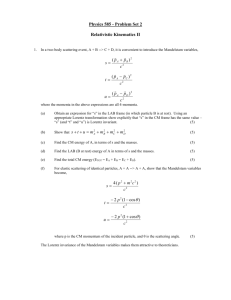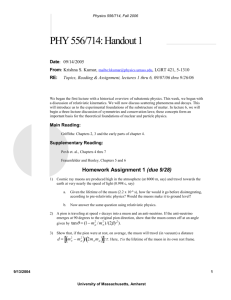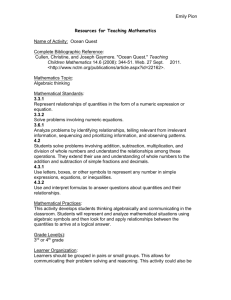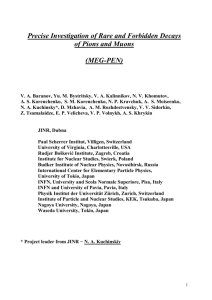Phase Space Calculations of the Farley Beam
advertisement
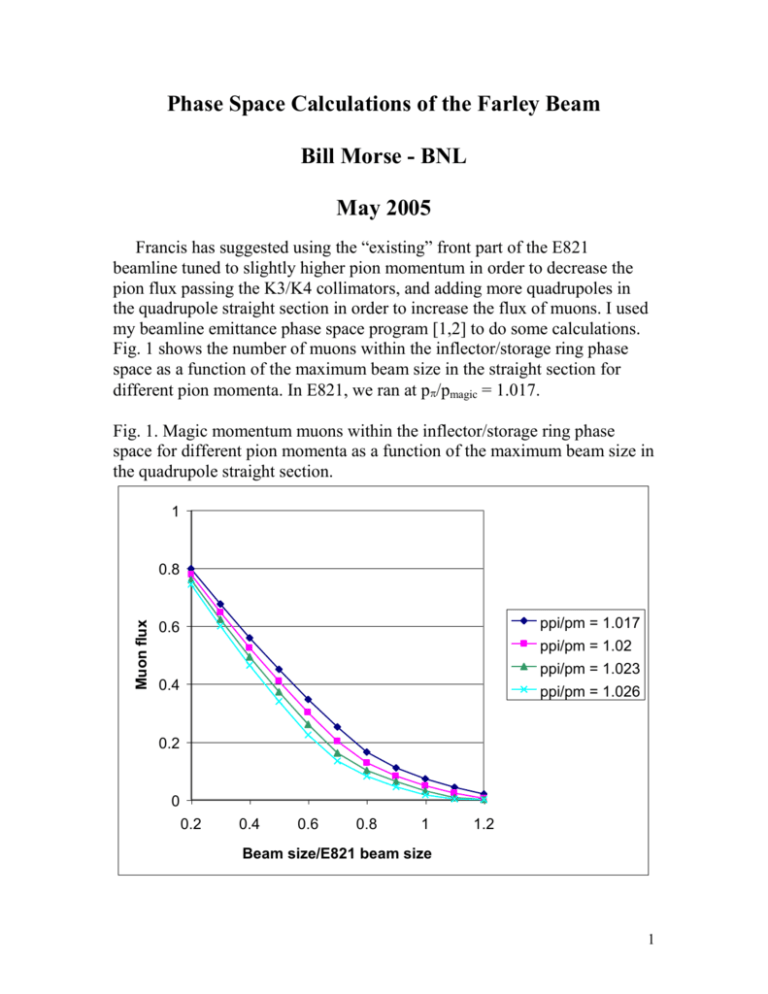
Phase Space Calculations of the Farley Beam Bill Morse - BNL May 2005 Francis has suggested using the “existing” front part of the E821 beamline tuned to slightly higher pion momentum in order to decrease the pion flux passing the K3/K4 collimators, and adding more quadrupoles in the quadrupole straight section in order to increase the flux of muons. I used my beamline emittance phase space program [1,2] to do some calculations. Fig. 1 shows the number of muons within the inflector/storage ring phase space as a function of the maximum beam size in the straight section for different pion momenta. In E821, we ran at p/pmagic = 1.017. Fig. 1. Magic momentum muons within the inflector/storage ring phase space for different pion momenta as a function of the maximum beam size in the quadrupole straight section. 1 Muon flux 0.8 ppi/pm = 1.017 0.6 ppi/pm = 1.02 ppi/pm = 1.023 0.4 ppi/pm = 1.026 0.2 0 0.2 0.4 0.6 0.8 1 1.2 Beam size/E821 beam size 1 As we increase the pion momentum, the pion flux which survive the K3/K4 collimators decreases [3]. This is shown in Table 1. Table 1. K3/K4 pion survival vs. pion momentum. BTRAF is Hugh Brown’s beamline program. Pion p above pmagic 1.5% 1.7% 2.0% E821 pion survival 6.5% 1.6% 0.9% BTRAF pion survival 3.7% 0.2% 0.0 BTRAF predicts that no pions survive when the pion momentum is 2% above the magic momentum. However, Hugh said that BTRAF does not include scattering off the collimator faces. The reason we didn’t run at higher pion momentum for E821 is illustrated in Fig. 2. Fig. 2. Ratio of muon flux at 1.026pmagic to 1.017pmagic pion momentum vs. beam size in the quadrupole channel. muon flux ppi/pm = 1.026/1.017 5 4 3 2 1 0 0.2 0.4 0.6 0.8 1 Beam size/E821 beam size For E821 we would have lost a factor of 5 in muon flux by running at 2.6% above the magic momentum, compared to 1.7%. Since our g-2 result is dominated by statistical errors, not systematic errors, this would have been a bad idea. However, as the maximum beam size is reduced, this relative loss is much less. 2 As p/pmagic is increased, the muon polarization drops [1]. The muon NP2 is shown in Table 2 for the case of one half the E821 beam size from the above phase space calculations. Table 2. Muon NP2 vs. p/pmagic for one half the E821 beam size. One million pions were generated. The NP2 for the E821 beam size and the E821 p/pmagic is only 65K. p/pmagic 1.017 1.020 1.023 1.026 N 450K 409K 373K 339K P 0.96 0.95 0.94 0.93 NP2 415K 369K 330K 293K In conclusion, for p/pmagic = 1.02 with one half the E821 beam size, the pion flux would be less than the E821 pion flux by a factor of 0.56 (measurement), and the muon NP2 would be greater by a factor of 5.7 (phase space simulation). Including a new inflector with open ends would increase the stored muon flux by another factor of 2 [4]. Going to higher p/pmagic would reduce the pion flux by even more, but we would need to simulate pion scattering from the K3/K4 collimator faces to know by how much. Francis has suggested going to higher p/pmagic with a larger pion p/p, but this opens up the chromaticity issues discussed by Peter and Sara at the last meeting. Of course, all the caveats about phase space emittance calculations given in refs. 1 and 2 still hold here. I want to thank Francis; he comes up with very many innovative ideas, and some of them are actually also good ideas. References 1. W. Morse, g-2 Note 303 (1998). 2. W. Morse, g-2 Note 448 (2004). 3. W. Morse, g-2 Note 317 (1998). 4. E821 Design Report, p. 210 (1995). 3
